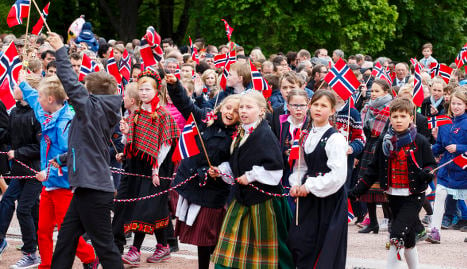NATIONAL DAY
Norwegians brave rain and cold for May 17 gala
Neither the rain and 4C temperatures, nor the comedown from last year’s bicentenary did much to dampen the enthusiasm of the crowds who come out to celebrate May 17, or ‘syttende mai’ in Oslo on Sunday.
Published: 18 May 2015 09:26 CEST

The children's parade in Oslo's palace square on May 17th. Photo: Heiko Junge / NTB scanpix
More than 60,000 children took part in a parade up Karl Johans Gate to the Royal Palace to mark, the central event in an annual outburst of national pride that is unmatched by any other Scandinavian country.
This year it was the 70th anniversary of the end of German occupation that made the year’s celebration special, something Norway’s Dagbladet newspaper commemorated with a video of the momentous 1945 festivities.
At the palace, the children’s parade was greeted by King Harald, Queen Sonja, Crown Prince Haakon, Crown Princess Mette-Marit, and their three children, continuing a tradition started by King Haakon in 1906.
Mette-Marit started the day wearing a traditional ‘bunad’ costume from her home county of Vest-Agder, as did Marius, her son from before her marriage to Haakon, ending the week-long speculation in Norwegian celebrity magazines.
But after greeting a children’s parade to the Crown family’s official residence in Skaugum, just outside Oslo, in her traditional clothes, Mette-Marit changed into a dark suit, in which she greeted the Oslo parade.
Olemic Thommessen, the President of the Norwegian Parliament, or Storting, sought to inaugurate a new tradition, laying a wreath for the first time at the foot of a statue of Christian Frederik, who was elected King of Norway at the time of Norway’s declaration of independence in 17 May 1814.
Record numbers of Norwegians bought traditional bunad costumes ahead of Sunday’s National Day celebrations, Norway’s Aftenposten newspaper reported on Sunday, indicating that the downturn in the economy hasn’t stopped the country wanting to celebrate in style.
Traditional costumiers Norsk Flid reported a ten percent jump in turnover to 160 millioner kroner.
“We set an all-time record for sales of national costumes and accessories in 2014, despite the fact that we are experiencing much greater competition in the market,” Per Willy Nesset, from the company told the paper.
According to the Norwegian Institute for bunad and folk costume, two thirds of Norwegian women and a fifth of Norwegian men own the costumes, which can cost more than 80,000 kroner ($10,000).
Although ethnic Norwegians are limited to wearing the bunad of their region of origin, the growing numbers of Norwegians of immigrant backgrounds in Oslo and other major cities, are changing the demand patterns for Bunad.
According to Cecilie Eskild, information officer at Heimen Handicrafts, the traditional Telemark bunad tends to the most popular among immigrant Norwegians.
“In Oslo, almost everyone’s an immigrant, and then you can choose the national costume you like best. There are a remarkable number of people wearing Telemark in Solli Square on May 17,” she said.
So great was the interest in bunad this year that Norway’s Verdens Gang newspaper announced a contest to find the most beautiful regional Bunad.
More than 73 000 readers voted, with the Nordlandsbunad winning the contest hands down.
Url copied to clipboard!


 Please whitelist us to continue reading.
Please whitelist us to continue reading.